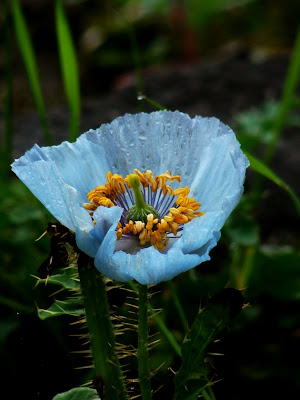
Why this blog is called "Gallimaufry".
gal-uh-MAW-free\, noun.
Originally meaning "a hash of various kinds of meats," "gallimaufry" comes from French galimafrée; in Old French, from the word galer, "to rejoice, to make merry"; in old English: gala + mafrer: "to eat much," and from Medieval Dutch maffelen: "to open one's mouth wide."
It's also a dish made by hashing up odds and ends of food; a heterogeneous mixture; a hodge-podge; a ragout; a confused jumble; a ridiculous medley; a promiscuous (!) assemblage of persons.
Those of you who know me, will, I’m sure, understand how well some of these phrases (barring the "promiscuous" bit!) fit me.
More importantly, this blog is an ode to my love for Shimla. I hope to show you this little town through my eyes. If you don't see too many people in it, forgive me, because I'm a little chary of turning this into a human zoo.
Stop by for a spell, look at my pictures, ask me questions about Shimla, if you wish. I shall try and answer them as best as I can. Let's be friends for a while....
23 August 2010
For through my lips may breathe adieu, I cannot think the thing farewell.

21 August 2010
Pleasures are like poppies spread, You seize the flow'r, its bloom is shed...

17 August 2010
Loneliness is solitude with a problem!
If you are at first lonely, be patient.
If you’ve not been alone much, or if when you were, you weren’t okay with it, then just wait. You’ll find it’s fine to be alone once you’re embracing it.
We can start with the acceptable places, the bathroom, the coffee shop, the library, where you can stall and read the paper, where you can get your caffeine fix and sit and stay there. Where you can browse the stacks and smell the books; you’re not supposed to talk much anyway so it’s safe there.
There is also the gym, if you’re shy, you can hang out with yourself and mirrors, you can put headphones in.
Then there’s public transportation, because we all gotta go places.
And there’s prayer and mediation, no one will think less if your hanging with your breath seeking peace and salvation.
Start simple. Things you may have previously avoided based on your avoid being alone principles.
The lunch counter, where you will be surrounded by “chow downers”, employees who only have an hour and their spouses work across town, and they, like you, will be alone.
Resist the urge to hang out with your cell phone.
When you are comfortable with “eat lunch and run”, take yourself out for dinner; a restaurant with linen and Silverware. You’re no less an intriguing a person when you are eating solo desert and cleaning the whip cream from the dish with your finger. In fact, some people at full tables will wish they were where you were.
Go to the movies. Where it’s dark and soothing, alone in your seat amidst a fleeting community.
And then take yourself out dancing, to a club where no one knows you, stand on the outside of the floor until the lights convince you more and more and the music shows you. Dance like no one’s watching because they’re probably not. And if they are, assume it is with best human intentions. The way bodies move genuinely to beats, is after-all, gorgeous and affecting. Dance until you’re sweating. And beads of perspiration remind you of life’s best things. Down your back, like a book of blessings.
Society is afraid of alone though. Like lonely hearts are wasting away in basements. Like people must have problems if after awhile nobody is dating them.
But lonely is a freedom that breathes easy and weightless, and lonely is healing if you make it.
You can stand swathed by groups and mobs or hands with your partner, look both further and farther in the endless quest for company.
But no one is in your head. And by the time you translate your thoughts an essence of them maybe lost or perhaps it is just kept. Perhaps in the interest of loving oneself, perhaps all those “sappy slogans” from pre-school over to high school groaning, we’re tokens for holding the lonely at bay.
Cause if you’re happy in your head, then solitude is blessed, and alone is okay.
It’s okay if no one believes like you, all experiences unique, no one has the same synapses, can’t think like you, for this be relived, keeps things interesting, life’s magic things in reach, and it doesn’t mean you aren’t connected, and the community is not present, just take the perspective you get from being one person in one head and feel the effects of it.
Take silence and respect it.
If you have an art that needs a practice, stop neglecting it, if your family doesn’t get you or a religious sect is not meant for you, don’t obsess about it.
You could be in an instant surrounded if you need it.
If your heart is bleeding, make the best of it.
There is heat in freezing, be a testament.
15 August 2010
There is flattery in friendship.
14 August 2010
That foolish fort, a heart...





11 August 2010
Dogs got personality. Personality goes a long way.





8 August 2010
By this merit may all attain omniscience. May it defeat the enemy, wrongdoing.



7 August 2010
The dew-drop carries in its eye, mountain and forest, sea and sky,
3 August 2010
The motion of light, spills itself in astonished seed

2 August 2010
Old age, calm, expanded, broad with the haughty breadth of the universe... flowing free with the delicious near-by freedom of death.


It ought to be lovely to be old
to be full of the peace that comes of experience
and wrinkled ripe fulfilment.
The wrinkled smile of completeness that follows a life
lived undaunted and unsoured with accepted lies
they would ripen like apples, and be scented like pippins
in their old age.
Soothing, old people should be, like apples
when one is tired of love.
Fragrant like yellowing leaves, and dim with the soft
stillness and satisfaction of autumn.
And a girl should say:
It must be wonderful to live and grow old.
Look at my mother, how rich and still she is! -
And a young man should think: By Jove
my father has faced all weathers, but it's been a life!
























